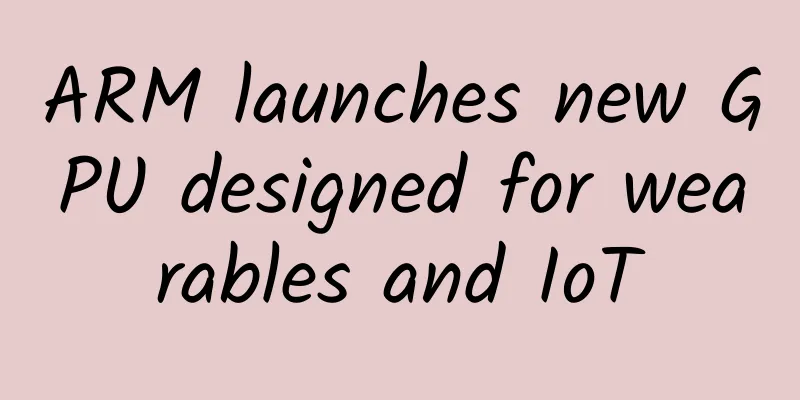ARM launches new GPU designed for wearables and IoT

|
ARM's media processor division recently released a new high-efficiency graphics processor, the Mali-470 GPU, which is designed for wearable devices and IoT devices, and aims to bring visual effects comparable to smartphones to these two platform products. The biggest advantage of Mali-470 is that it has a 50% performance improvement over Mali-400, which can help manufacturers bring graphics processing capabilities comparable to smartphones.
The market size continues to grow The wearable device market has been growing in recent years, and more and more devices and apps have begun to appear. ARM has always been closely related to wearable devices, and many products use ARM architecture processors. Now ARM has launched a new Mali-470 GPU. It is reported that Mali-470 is the latest product in the Mali-400 series, which allows applications to run OpenGL ES 2.0 graphics standards. Currently, Mali-400 series GPUs have been used in more than 1 billion devices worldwide and have very efficient graphics processing capabilities. Many processors equipped with Mali-400 GPUs are used in wearable devices and IoT products, such as MediaTek MT2601 chip, which announced support for Google Android Wear system and devices at the beginning of this year. The biggest advantage of Mali-470 is that it has a 50% performance improvement over Mali-400, which can help manufacturers bring graphics processing capabilities comparable to those of smartphones. Expanding the smartphone user experience We all like to enjoy high-quality images on the touch screens of smart devices, and this has become the most basic way for us to interact with smartphones and tablets. Therefore, we also need the same experience as smartphones on other types of products. However, for some products such as camcorders and cameras, the operational user experience is still not comparable to that of smartphones, and some are even very bad. From watches to thermostats, industrial equipment controllers, warehouse equipment, office printers, in-car infotainment systems, and home appliances, the same excellent operating experience is required. For such devices, how to improve the interface quality while consuming less energy is the problem that Mali-470 can solve. Why OpenGL ES 2.0? In a high-quality user interface, every pixel counts, especially on small screens, where every pixel plays an important role in conveying information and making interactions more intuitive. Currently, most emerging operating systems such as Android, Android Wear and Tizen use OpenGL ES 2.0, which can bring an optimal balance between pixel control, shading and energy saving. OpenGL ES 2.0 can enable Mali-470 to bring a more seamless experience in all applications. The latest version of OpenGL ES adds a lot of additional features, such as a more realistic video game experience, and such an experience can also have the same effect on wearable devices and IoT devices. Cut energy consumption in half In addition to continuing the success of Mali-400, Mali-470 also reduces energy consumption by almost half while maintaining performance, which gives chip manufacturers more room to embed more graphics systems to meet the needs of low-power devices. |
<<: The 10 worst unicorns of 2015: Evernote and Dropbox are on the list
>>: Ma Huateng said that this is the third thing he is optimistic about after WeChat
Recommend
Teacher Xiaoye's "Mobile Photography Practical Course" thinking + practice, a one-stop shooting and editing tutorial
Training course video content introduction: Teach...
A study of 475,000 people revealed: People who walk fast live 20 years longer? Must read →
In daily life, walking is one of the most common ...
The most comprehensive guide to advertising and optimization for Baidu, Tencent, Toutiao, etc.! !
Some time ago, when Tu Zi was browsing the websit...
How much does it cost to be an agent for a tea mini program in Anyang?
Anyang Tea Mini Program Agents are generally divi...
Never expected | Don’t take it lightly, this kind of harm damages the brain in seconds!
Review expert: Peng Guoqiu, deputy chief physicia...
Is there a world in a small space? The "Yangshi Lei" pattern contains great architectural wisdom!
Figure 1 shows the Hall of Supreme Harmony in the...
SAIC's "Internet × New Energy" strategic upgrade extends to B-class vehicles to form full coverage
SAIC's "Internet × New Energy" strat...
New gameplay of Douyin Blue V Matrix
1. What is a matrix? The advanced method of accou...
Most Unreliable iPhones and Android Phones: Samsung Tops the List
The price of iPhone is not cheap, so what about it...
Why do we sometimes have to wait for half an hour for a bus that runs every 10 minutes?
Commuting is a topic that modern people cannot av...
Heart regeneration is no longer a dream? Please "patch" the failing heart
The heart is one of the most important organs in ...
Here is a Valentine's Day marketing promotion guide, please check it out!
Show affection and give gifts as they should (the...
Alipay collects the five blessings in 2020, and the 2020 Alipay blessing card collection guide is here!
It’s time to count the days and look forward to t...
How can the elderly prevent lower extremity venous thrombosis? What symptoms indicate lower extremity venous thrombosis?
During the ward rounds today, 65-year-old lung ca...









